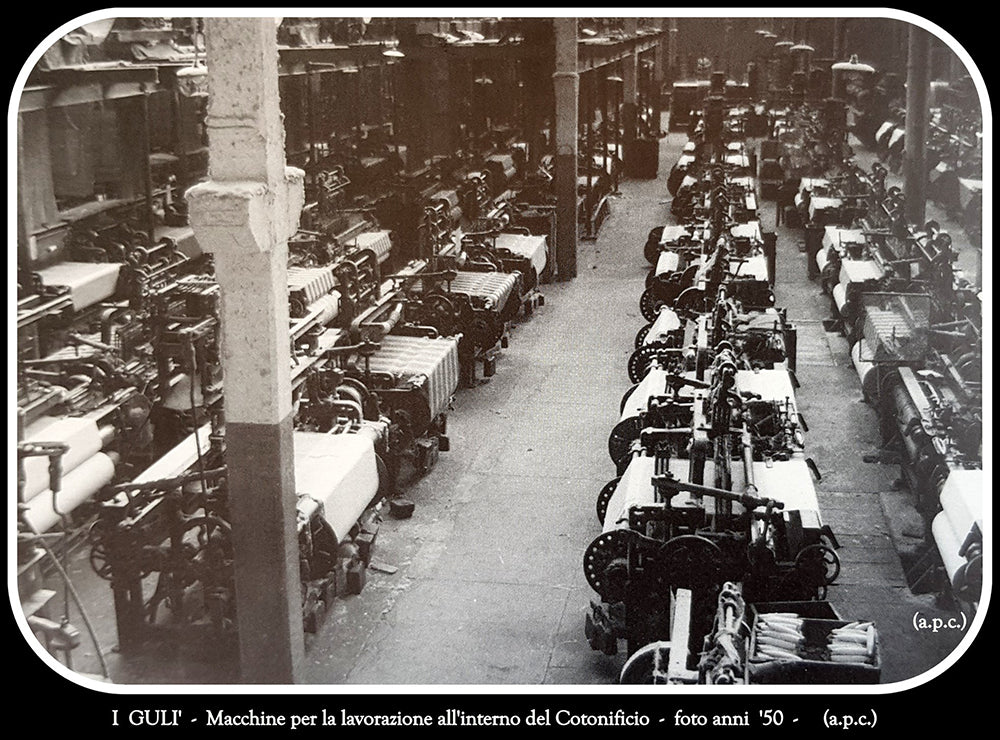GULI' and Sicilian Textiles
In 1882, the young Giuseppe Guli' purchased four wooden looms to venture into silk processing and established what would become the renowned textile factory Gulì in Palermo. This company would remain active until the 2000s, accompanying the family's history and leaving a mark on Palermo for over a century.

With the support of his father Vincenzo, a textile worker, Giuseppe Gulì, at just 35 years old, pursued his entrepreneurial calling. Together, they founded the first textile establishment in Palermo, on Via Mura Porta Carini, close to their family home. Giuseppe began producing silk organzine and precious damasks, captivating the city's attention, particularly the aristocrats and affluent bourgeoisie.
One of their early significant projects was creating silk organzine wallpapers for Palazzo Mazzarino between 1891 and 1892. During this period, "Tessitura Giuseppe Gulì fu Vincenzo" acquired four modern mechanical looms, enabling them to produce contemporary and cutting-edge items. Their production quickly gained popularity, reaching not just Palermo but also Italy and beyond.
By 1915, the factory employed 70 workers, and they opened a store on Via Bandiera in Palermo. Affluent families flocked there to purchase the famous "madapolam," a fine cotton and linen fabric used for sheets and handkerchiefs.


In 1938, the original facility was expropriated to build the new Palace of Justice, leading the family to relocate to a new venue: Villa Belmonte in the Noce district. This neoclassical noble residence from the early 19th century, belonging to Giuseppe Emanuele Ventimiglia, Prince of Belmonte, became the new family home and the site of a modern textile factory, which reopened in June 1939.

When World War II began, yarns for processing became scarce, prompting the family to directly engage in spinning Sicilian cotton from their plantations in the Trapani area, resulting in the establishment of a dedicated department.
The 1950s marked further growth and development, with the company now spanning three generations. In 1961, they inaugurated their first new retail store on Via Mariano Stabile in Palermo, and by 1965, they completed the automated Spinning-Dyeing-Weaving cycle. Exports increased, as did the number of factory workers. The family also prioritized their well-being, adding a canteen and a nursery in the facility. At the time, the concept of women's roles in society evolved, and the need to empower them led to the birth of the nursery, an uncommon response to such needs during that era.

In 1987-1988, they constructed a new factory in Carini, just outside Palermo, where they offered a wide range of textile products, including tablecloths, bed sheets, fire-resistant fabrics, curtains, mattresses, awnings, and exquisite fabrics for trousseaux and furnishings, such as damasks and brocades.

However, in 1994, the new Palermo Urban Plan led to the dismantling of the factory on Via Noce, declaring it a "historical site" and imposing restrictions. Production continued only in Carini for a period before the machinery in Via Noce was demolished between 2006 and 2007, and later the Carini facility also closed.
From that moment, the Guli' family experienced a decline along with the production of their fine fabrics and factories, which had brought Sicily's name to prominence in the textile industry, contributing to its economic and cultural growth.
The Guli' family's story embodies the values of Sicily: perseverance, tenacity, delicacy, and fragility, reflecting a precious treasure trove of culture, beauty, and manufacturing excellence. The company logo, featuring an eagle accompanied by the Genius of Palermo and the motto "persevere and conquer," epitomizes the determination and success of this entrepreneurial family.


